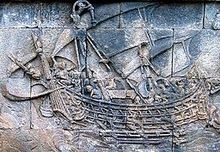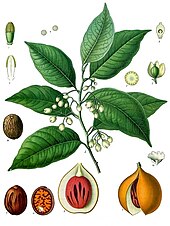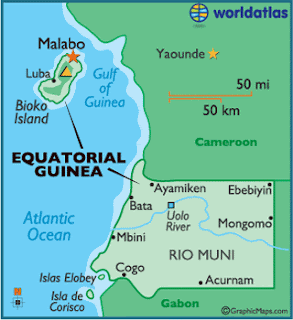Republic of equitorial Guinea, formerly Spanish Guinea, has as its major components the mainland province of Rio Muni and the Island of Bioko. The Fang is the largest group inhabited in Rio Muni with its capital in Bata.
Malabo , the national capital, is on the island of Bioko, formerly called Fernando Po. Spain claimed the island in 1778, but it was not until 1910 that its Bubi inhatants recognized Spanish suzerainty. For most of the twentieth century
In the period following Spain's grant of local autonomy to Equatorial Guinea in 1963, there was a great deal of political party activity. Bubi and Fernandino parties on the island preferred separation from Río Muni or a loose federation. Ethnically based parties in Río Muni favored independence for a united country comprising Bioko and Río Muni, an approach that ultimately won out. (The Movement for the Self-Determination of Bioko Island (MAIB) which advocates independence for the island under Bubi control, is one of the offshoots of the era immediately preceding independence).
Equatorial Guinea became officially independent from Spain on October 12, 1968. Since then, the country has had two presidents: Francisco Macías Nguema, the former mayor of Mongomo under the Spanish colonial government, and Teodoro Obiang Nguema Mbasogo (Macías's nephew), who has ruled since 1979 when he staged a military coup d'état and executed Macías.
The 1982 constitution of Equatorial Guinea gives Obiang extensive powers, including naming and dismissing members of the cabinet, making laws by decree, dissolving the Chamber of Representatives, negotiating and ratifying treaties and calling legislative elections. Obiang retains his role as commander-in-chief of the armed forces and minister of defense, and he maintains close supervision of the military activity. The Prime Minister is appointed by the President and operates under powers designated by the President. The Prime Minister coordinates government activities in areas other than foreign affairs, national defense and security.
After the accession of Macías to power, political activity largely ceased in Equatorial Guinea. Opposition figures who lived among the exile communities in Spain and elsewhere agitated for reforms; some of them had been employed in the Macías and Obiang governments. After political activities in Equatorial Guinea were legalized in the early 1990s, some opposition leaders returned to test the waters, but repressive actions have continued sporadically.
With the prodding of the United Nations, the United States, Spain, and other donor countries, the government undertook an electoral census in 1995. Freely contested municipal elections, the country's first, were held in September. Most observers agree that the elections themselves were relatively free and transparent and that the opposition parties garnered between two-thirds and three-quarters of the total vote. The government delayed announcement of the results and then claimed a highly dubious 52% victory overall and the capture of 19 of 27 municipal councils. Malabo's council went to the opposition. In early January 1996 Obiang called presidential elections to be held in six weeks. The campaign was marred by allegations of fraud, and most of the other candidates withdrew in the final week. Obiang claimed re-election with 98% of the vote. International observers agreed the election was not free or fair. In an attempt to molify his critics, Obiang announced his new cabinet, giving minor portfolios to some people identified by the government as being opposition figures.
Since independence, the two Presidents (Macías and Obiang) have been the dominant political forces in Equatorial Guinea. Since 1979, President Obiang has been constrained only by a need to maintain a consensus among his advisers and political supporters, most of whom are drawn from the Nguema family in Mongomo, in the eastern part of Río Muni. The Nguema family is part of the Esangui subclan of the Fang. Alleged coup attempts in 1981 and 1983 raised little sympathy among the populace.
President Obiang's rule, during which schools were permitted to reopen and primary education expanded, and public utilities and roads restored, compares favorably with Macías' tyranny and terror. It has been criticized for not implementing genuine democratic reforms. Corruption and a dysfunctional judicial system disrupt the development of Equatorial Guinea's economy and society. In March 2001 the President appointed a new Prime Minister, Cándido Muatetema Rivas, and replaced several ministers perceived to be especially corrupt. However, the government budget still does not include all revenues and expenditures. The United Nations Development Programme has proposed a broad governance reform program, but the Equatorial Guinean Government has not moved rapidly to implement it.
Although Equatorial Guinea lacks a well-established democratic tradition comparable to the developed democracies of the West, it has progressed toward developing a participatory political system out of the anarchic, chaotic, and repressive conditions of the Macias years. In power since 1979, the Obiang government has made little progress in stimulating the economy. Extremely serious health and sanitary conditions persist, and the educational system remains in desperate condition. Although the abuses and atrocities that characterized the Macias years have been eliminated, effective rule of law does not exist. Religious freedom is tolerated.
On December 15, 2002, Equatorial Guinea's four main opposition parties withdrew from the country's presidential election. Obiang won an election widely considered fraudulent by members of the western press.
According to a March 2004 BBC profile politics within the country are currently dominated by tensions between Obiang's son Teodoro (known by the nickname Teodorín, meaning Little Teodoro), and other close relatives with powerful positions in the security forces. The tension may be rooted in a power shift arising from the dramatic increase since 1997 in oil production.
A November 2004 report named Mark Thatcher as a financial backer of a March 2004 attempt to topple Obiang organized by Simon Mann. Various accounts also name the UK's MI6, the US Central Intelligence Agency, and Spain as having been tacit supporters of the coup attempt. Nevertheless, an Amnesty International report on the ensuing trial highlights the government's failure to demonstrate in court that the alleged coup attempt had ever actually taken place.
Executive branchMain office holders Office Name Party Since
President Teodoro Obiang Nguema Mbasogo Democratic Party of Equatorial Guinea 3 August 1979
Prime Minister Vicente Ehate Tomi Democratic Party of Equatorial Guinea 21 May 2012
The 1982 constitution of Equatorial Guinea gives the President extensive powers, including naming and dismissing members of the cabinet, making laws by decree, dissolving the Chamber of Representatives, negotiating and ratifying treaties and calling legislative elections. The President retains his role as commander in chief of the armed forces and minister of defense, and he maintains close supervision of the military activity. The Prime Minister is appointed by the President and operates under powers designated by the President. The Prime Minister coordinates government activities in areas other than foreign affairs, national defense and security. Teodoro Obiang Nguema Mbasogo seized power in a military coup. He is elected by popular vote to a seven-year term.
Another official branch of the government is the State Council. The State Council's main function is to serve as caretaker in case of death or physical incapacity of the President. It comprises the following ex officio members: the President of the Republic, the Prime Minister, the Minister of Defense, the President of the National Assembly and the Chairman of the Social and Economic Council.
Legislative branch This section does not cite any references or sources. (December 2008)
The Chamber of People's Representatives (Cámara de Representantes del Pueblo) has 100 members, elected for a five year term by proportional representation in multi-member constituencies. Equatorial Guinea is a One party dominant state. This means that only one political party, the Democratic Party of Equatorial Guinea, is in fact allowed to hold effective power. Although minor parties are allowed, they are de facto required to accept the leadership of the dominant party
 For most of the colonial period, Dutch control over the archipelago was tenuous outside of coastal strongholds; only in the early 20th century did Dutch dominance extend to what was to become Indonesia's current boundaries. Despite major internal political, social and sectarian divisions during the Indonesian National Revolution, Indonesians, on the whole, found unity in their fight for independence. Japanese occupation during World War II ended Dutch rule, and encouraged the previously suppressed Indonesian independence movement. A later UN report stated that four million people died in Indonesia as a result of famine and forced labor during the Japanese occupation. Two days after the surrender of Japan in August 1945, Sukarno, an influential nationalist leader, declared independence and was appointed president. The Netherlands tried to reestablish their rule, and the resulting conflict ended in December 1949, when in the face of international pressure, the Dutch formally recognized Indonesian independence (with the exception of the Dutch territory of West New Guinea, which was incorporated into Indonesia following the 1962 New York Agreement, and the UN-mandated Act of Free Choice of 1969).
For most of the colonial period, Dutch control over the archipelago was tenuous outside of coastal strongholds; only in the early 20th century did Dutch dominance extend to what was to become Indonesia's current boundaries. Despite major internal political, social and sectarian divisions during the Indonesian National Revolution, Indonesians, on the whole, found unity in their fight for independence. Japanese occupation during World War II ended Dutch rule, and encouraged the previously suppressed Indonesian independence movement. A later UN report stated that four million people died in Indonesia as a result of famine and forced labor during the Japanese occupation. Two days after the surrender of Japan in August 1945, Sukarno, an influential nationalist leader, declared independence and was appointed president. The Netherlands tried to reestablish their rule, and the resulting conflict ended in December 1949, when in the face of international pressure, the Dutch formally recognized Indonesian independence (with the exception of the Dutch territory of West New Guinea, which was incorporated into Indonesia following the 1962 New York Agreement, and the UN-mandated Act of Free Choice of 1969).































